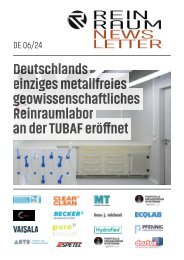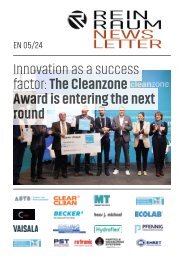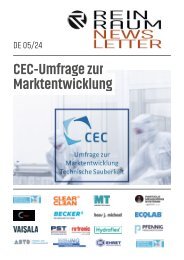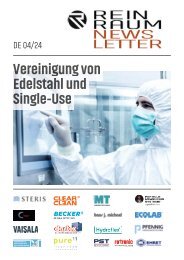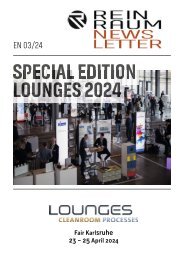Newsletter_04-2024_EN
You also want an ePaper? Increase the reach of your titles
YUMPU automatically turns print PDFs into web optimized ePapers that Google loves.
preparations, the so-called injectables. Already in the years before
the pandemic, machine manufacturers had registered a strongly
growing demand for ready-to-fill syringes. The enormous demand
for vaccines in the Corona years 2020 to 2022 had recently caused
a revival of bulk packaging such as vials, but in the meantime the
share of „ready-to-use“ (RTU) syringes is rising again significantly.
With RTU syringes, for example, the medicine is filled directly into
a sterilised syringe. This not only reduces the risk of contamination
during preparation and administration, but also avoids dosing errors.
The customer‘s desire to find better packaging solutions for less
money is therefore driving the machine manufacturers. And one
keyword runs through the description of most new developments:
Flexibility. Syntegon, for example, has developed the Versynta flexible
filling system as a platform with which biopharmaceuticals
can be filled both in RTU syringes and in bulk packaging in the isolator.
To significantly reduce project times, supplier Groninger also
relies on flexibility with the Flexfill concept, but combines it with
standardised modules that are also housed in the isolator or RABS.
Bausch+Ströbel also relies on modularisation and has radically reduced
the number of format parts in the new CombiSys line. This makes
it comparatively easy to convert the machine from vials to RTU
packaging, for example.
New transport systems and digital technologies
Bausch+Ströbel kills two birds with one stone with a new magnetic
transport system that moves the packaging material through the machine:
In contrast to common drives, a fixed cycle time is no longer
required, which increases flexibility. At the same time, the magnetic
drive makes wipers and bellows seals unnecessary, thus eliminating
a cause of contamination in the sterile area. Optima has also addressed
the transport of packaging materials in the machine: With the
new FillCell formatless transport system, the main aim is to increase
product yield. Especially with expensive active ingredients, it is important
to avoid losses during machine start-up.
Machine manufacturers are taking this requirement into account
with new dosing and filling systems, but also optimised transport,
monitoring and labelling solutions. Digital technologies are playing
an increasingly important role here: this begins with training operators
with virtual reality goggles on digitised equipment, extends to
the seamless recording of production parameters in the production
process, and ends with the evaluation and visualisation of key figures
such as Overall Equipment Effectiveness (OEE), which are becoming
more and more important in the growing competition of the
pharmaceutical industry.
The Körber Group, for example, has dedicated itself to this topic,
using its Manufacturing Execution System (MES) to analyse
the operational efficiency of biopharmaceutical manufacturing processes
on the basis of different and previously unnetworked data.
Among other things, this should enable biopharmaceutical manufacturers
to significantly accelerate their time-to-market. Uhlmann
Pac-Systeme networks machines and entire plants of any manufacturer
via interfaces with a new software (Pexcite), thus enabling centralised
monitoring and control. In addition to looking at line efficiency
and planning set-up times, this also makes it easier to comply
with regulatory obligations.
Robots in glove-free isolator, scalable parenterals production
The automation strategy of many manufacturers now includes the
use of robots - not only at the end of the line, for example to stack packaged
medicines on pallets, but already in the sterile isolator. Machine
developers are benefiting from the fact that, on the one hand,
the range of cleanroom-suitable robots is steadily growing, while at
the same time the costs for robotics are continually falling. In this
way, automated solutions are increasingly replacing the otherwise
necessary gloved interventions on the isolator. This is because in the
demanding sterile production of high-quality medicines, human intervention
is increasingly being perceived as a nuisance and is being
replaced by technical solutions.
At the machine manufacturer IMA, the gloveless aseptic process
in the isolator is being promoted under the name „Injecta“. But the
machine manufacturers already mentioned are also pursuing the
trend towards aseptic filling without human intervention with their
own solutions. The development is consistently implementing the
requirements of the new GMP Annex 1. In many places, this also includes
dispensing with the time-consuming sterilisation of the primary
packaging material by using sterile packaging materials.
In general, the packaging of sterile preparations for injection and
infusion (parenterals) is very demanding, and the machine technology
is expensive. This becomes a problem especially when the success
of a drug and its required quantity are not yet known. The folding
box manufacturer Faller Packaging has developed a scalable solution
to this problem together with the machine manufacturer Schubert-
Pharma: This starts with the initially manual loading of pre-prepared
folding box packaging. As soon as demand increases, cobots are used
until the process is finally switched to a fully automatic top-loading
machine.
Sustainability becomes important
But it is not only the development of the processes around the primary
packaging of medicines that follows the new requirements of
the pharmacists. Developments in secondary packaging in folding
boxes, trays and cartons are not standing still either. In addition to
flexibility and product safety, important trends here are resource optimisation
and low CO2 emissions. This is because the topic of sustainability
is also increasingly finding its way into companies in the
pharmaceutical industry via CSR and ESG criteria.
In order to improve the recyclability of packaging, Uhlmann, for
example, is increasingly relying on packaging made of monomaterial.
With the Parenteral Tray Center, the manufacturer has recently
also introduced a flexible „direct-in-carton“ solution that can pack
ampoules, vials and syringes both in cardboard trays made of monomaterial
and in conventional plastic clamp blisters. Recyclable
packaging places new demands on machine manufacturers. Close
coordination between machine and packaging supplier is therefore
important. At Faller Packaging, for example, the approach is called
3R: Redesign, Reduce, Recycle: in addition to the use of new recyclable
mono-materials, this also includes testing existing products and
processes with the aim of minimising the use of raw materials and
energy.
But labelling technology is also evolving. While in the past decade
this was mainly characterised by the fight against counterfeit
medicines, other requirements are now coming to the fore with regard
to biopharmaceuticals. One trend here is the development of
new labelling solutions with sensor functions. The so-called „smart
labels“ use printable indicators that can be used to monitor the correct
storage of a medicine or the correct application temperature. If
the heat or UV light exposure of the medicine exceeds a defined value,
the indicator on the packaging changes colour. Another piece of
the mosaic to be able to safely control biopharmaceutical mimosas
in everyday life.
DECHEMA Ausstellungs-GmbH
D 60486 Frankfurt am Main
www.reinraum.de | www.cleanroom-online.com NEWSLETTER | Edition EN 04-2024
page 27/35











